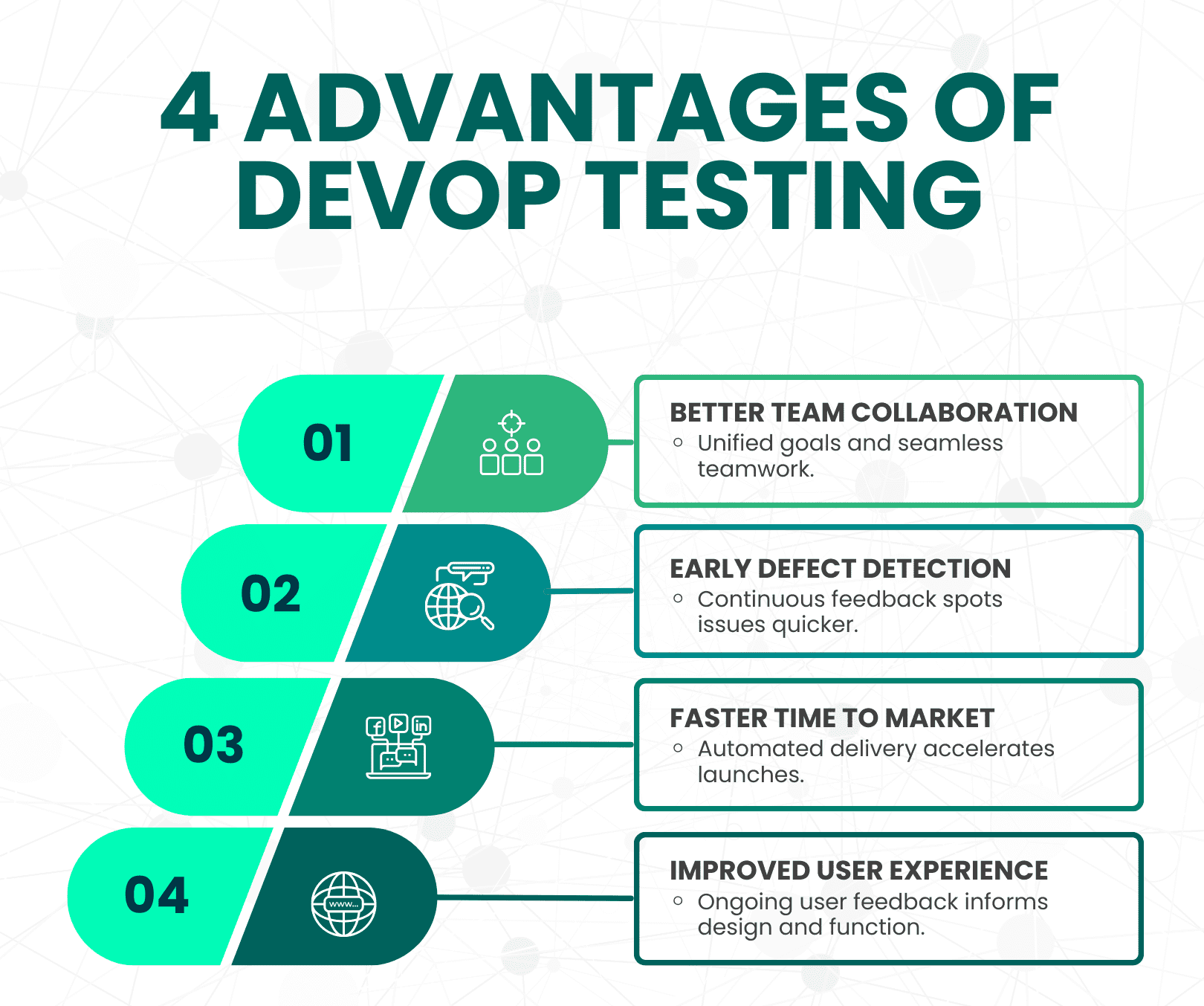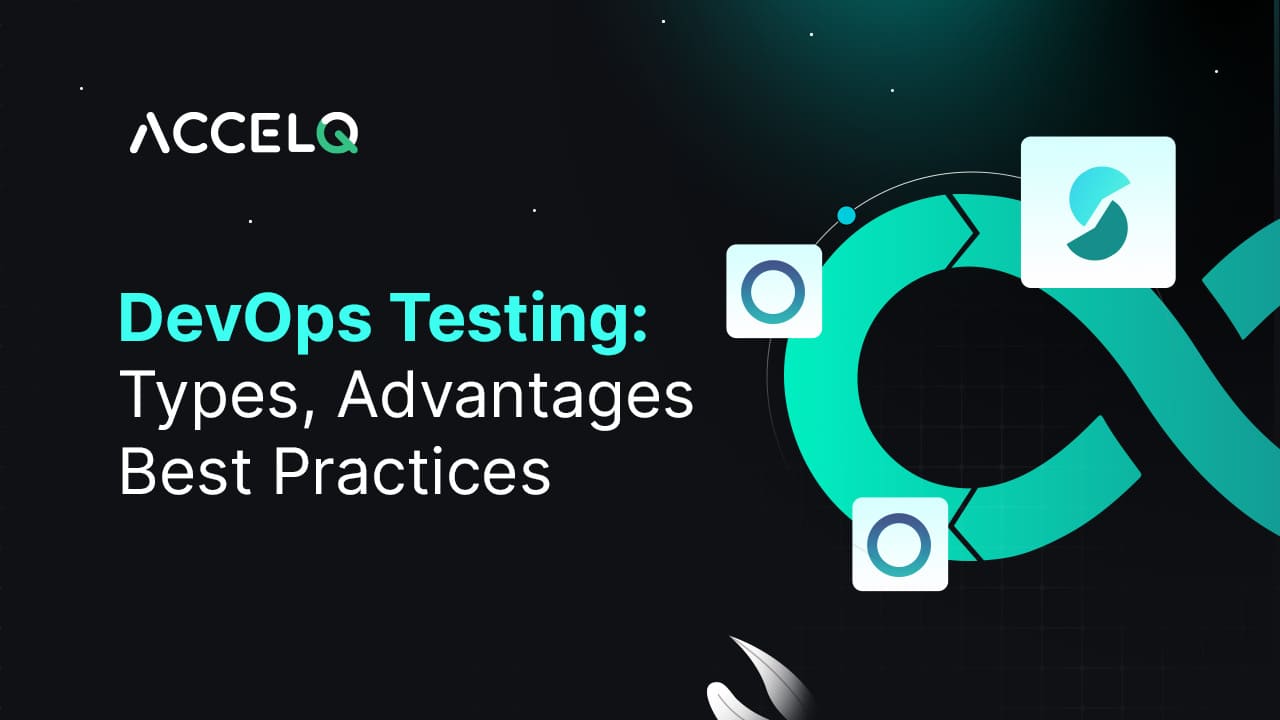DevOps Testing: Types, Advantages, Best Practices

DevOps testing occupies strategic importance in today's highly competitive software development market. The primary reason is that most major enterprise application development initiatives now adopt agile methodologies, with DevOps at their core.
Globally, the DevOps market size will grow to nearly $57.90 billion by 2030. This will directly influence the growth of testing in DevOps. However, even though enterprises have gotten accustomed to building a good DevOps strategy, DevOps testing isn't in the same league of awareness. Along those lines, in this blog, we will discuss
What Is DevOps Testing?

Over time, as software became a key driver of growth and revenue for organizations, there was a heightened transition to agile development methodologies with a focus on embracing DevOps services. DevOps brought in a continuous development and deployment model for software wherein all stages of the software life cycle mainly resided in the production environment.
DevOps testing comprises the new ways in which software delivered through a DevOps cycle is tested and verified for quality and reliability. The biggest difference from the traditional testing approach is that quality becomes an integral part of the entire lifecycle in DevOps testing.
Traditionally, the testing team entered the picture only at the final stage after coding. However, with DevOps testing, the QA team works in tandem with developers to continuously test the code while in production. As a result, the QA function becomes a key pillar of enabling the seamless application or feature release rather than staying in its traditional role of identifying and listing defects.
SUGGESTED READ - What is Azure DevOps and Why you Should Care
DevOps LifeCycle
While the DevOps lifecycle can be tailored to fit the unique needs of each organization, certain fundamental segments remain consistent across the board. Here's a breakdown of these essential stages:
The Planning Phase
Every DevOps journey begins with meticulous planning. Here, cross-functional teams converge to map out a tentative timeline for product development. Discussions span from potential launch dates to gauging the product's prospective success rate. In today's digital age, it's imperative that products resonate with societal values.
Therefore, considerations around product acceptability, potential controversies, and societal alignment are paramount. The overarching goal of this phase is to foster transparency, both within teams and with clients, ensuring everyone is on the same page and allowing for any necessary requirement adjustments.
Automation Testing
Automation testing is the linchpin of the DevOps culture, aiming to minimize human intervention. This stage involves a thorough check of the product's functionality using automation frameworks and specialized DevOps testing tools. Its primary benefits include bug detection, error reduction, repetitive test case execution, and bolstering product reliability.
The integration of test automation within the DevOps culture has revolutionized the role of the QA team. Gone are the days when QA would wait for the product to be finalized before testing, causing significant launch delays. With concurrent product development by multiple teams, such bottlenecks are now a thing of the past.
Deployment Automation
Once the product's functionality and security robustness are ascertained, the focus shifts to deployment. This stage involves a trial run to gauge the product's readiness for public launch. While deployment was traditionally manual, the rise of DevOps has ushered in an era of automated deployment.
Today, products can be deployed across diverse platforms, from public and private clouds to localized servers. This flexibility is especially invaluable for entities handling sensitive data, like government agencies.
Download the 100% Free Guide
Master the essentials of advanced approach
to object recognition.

DevOps Testing Types
Let's get into various types of tests commonly employed in a DevOps environment.
Chain Test:
Think of a chain made of multiple links. The Chain Test ensures that all the 'links' or apps in a sequence work harmoniously together. It's like making sure every piece of a puzzle fits just right.
Component Test:
Imagine a big machine with lots of parts. Each component needs to function correctly for the machine to work. The Component Test focuses on checking each of these individual parts.
Integration Test:
While the Component Test examines parts individually, the Integration Test checks how multiple components work together. It's like ensuring all the gears in a clock move in sync.
Performance Stress Test:
How much pressure can the system handle? This test pushes the system to its limits, checking its response to a high number of users and tasks.
Production Acceptance Test:
Before an app goes live, it's essential to ensure it'll work in its intended environment. This test does just that.
System Test:
Does the app meet all its requirements? The System Test gives a thumbs up (or down) based on how well the app meets its specified criteria.
Unit Test:
Zooming into the most minor parts or units, this test checks each tiny piece of the software in isolation.
User Acceptance Test:
At the end of the day, an app needs to be user-friendly. This test gets into the shoes of the user, ensuring the app is intuitive, easy to navigate, and meets user expectations.
What Are the Advantages of DevOps Testing?

Better Team Collaboration
DevOps testing brings on board the imbibed DevOps culture of seamless collaboration between development and operations teams. It instills a similar sense of teamwork for test engineers and the quality assurance practice.
Team members are assigned due responsibility to carry out their duties to satisfy engineering goals and remain adept on the quality front. In essence, the DevOps structure unifies team performance and ultimately improves productivity leading to faster and better team results.
Early Defect Detection
A DevOps testing strategy gives the organization an advantage by helping discover defects faster. Continuous monitoring, code testing, and collaborative knowledge and feedback sharing make it easier to improve build quality.
Defects detected by different teams are passed to other teams very early in the development process. This eliminates the chances of their re-creation in other scenarios.
Faster Time to Market
One of the biggest competitive advantages businesses can enjoy in the digital era is the speedy launch of applications or new features to the market. This helps them win customer attention and loyalty before their competition. To do so, they need to deploy code faster into production after completing quality checks.
We have already seen how DevOps testing improves the speed of defect detection. By integrating the core philosophies of DevOps like automation and continuous delivery, enterprises are looking at a development cycle that is significantly shortened compared to traditional methods.
Collaborative feedback propagation by teams helps identify similar defects faster and allows teams to rectify them using shared best practices. This helps in overall application release streamlining, thereby empowering enterprises to launch features faster.
Improved User Experience
The DevOps testing feedback cycle also includes incorporating routine feedback from end users about the deployed application. This creates a new dimension of functional testing. Here test engineers can create test scenarios that capture elements such as usability, navigation speed, performance on mobile devices, etc.
Moreover, they can set benchmarks for each element's performance against end user expectations captured via feedback. By leveraging continuous testing against benchmarks for future versions, they can improve user experience significantly.
Best Practices to Embed Testing into Their Core DevOps Strategy?
Now that the benefits of DevOps testing are clear, the next step is embedding a DevOps testing culture in an organization. If there wasn't any clear-cut software development practice in the business, it would be easy to implement a DevOps culture. And there will be total control over every aspect since it is just the beginning.
Bringing automation to the software delivery pipeline alone can streamline the entire development process and make way for the seamless introduction of quality practices in every stage of the development cycle.
However, suppose the DevOps testing strategy is to be introduced into an organization that already has a fully-grown software development practice. In that case, it is essential to follow some best practices. Here are some tips that can help you to reshape testing in a DevOps structure:
- Understand that testing needs to be a continuous and integrated part of the software lifecycle for best results.
- Identify the best type of testing to suit each phase of the software lifecycle to minimize the effort needed to backtrace in case of errors.
- Foster collaborative responsibility for ensuring high-quality code release.
- Embrace the shift left test approach to speed up testing activities by testing early and testing more.
- Leverage automation platforms and tools as much as possible for end-to-end test automation in all stages.
- Focus on using high-quality test data.
How Can Organizations Leverage Maximum ROI From DevOps Testing?
DevOps testing can help break traditional bottlenecks in application quality assurance. However, achieving quality milestones for testing in DevOps is not easy.
From following best practices to enabling transparent visibility into team management, the hurdles are many for businesses to surpass. To that end, one of the best ways to achieve maximum ROI is to select the right test automation platform to manage end-to-end test activities.
This is where ACCELQ can help bring a difference. Experience a free trial of our AI-powered test automation tool today to learn more about how to seamlessly automate your entire testing landscape for the best results.
Discover More
 Step-by-Step Guide: Mobile App Testing Process
Step-by-Step Guide: Mobile App Testing Process
Step-by-Step Guide: Mobile App Testing Process
 What Is Accessibility Testing? A Comprehensive Guide
What Is Accessibility Testing? A Comprehensive Guide
































